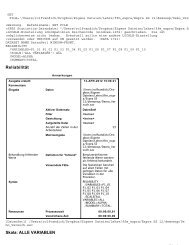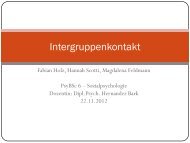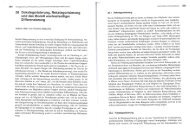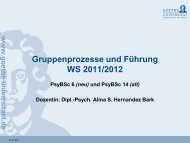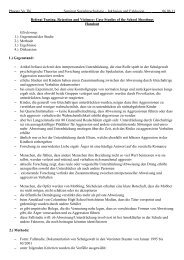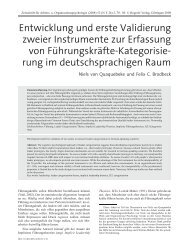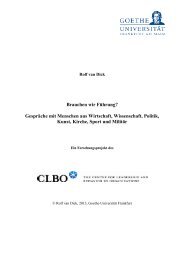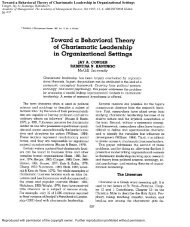SPSS macro for analyzing two-way interactions and simple slopes
SPSS macro for analyzing two-way interactions and simple slopes
SPSS macro for analyzing two-way interactions and simple slopes
Create successful ePaper yourself
Turn your PDF publications into a flip-book with our unique Google optimized e-Paper software.
For several reasons you might want to toggle the st<strong>and</strong>ardize comm<strong>and</strong> off (z=0). For<br />
instance, you may have more meaningful conditional values than 1 SD above/below the mean<br />
or do not want to st<strong>and</strong>ardize predictors because at least one of your predictors is a binary<br />
grouping variable. Cohen <strong>and</strong> his coauthors (2003) describe several useful coding schemes <strong>for</strong><br />
grouping variables.<br />
If you toggle the st<strong>and</strong>ardize comm<strong>and</strong> off, make sure your predictor variables are coded<br />
appropriately <strong>and</strong> specify the high <strong>and</strong> low conditional values. For instance, say the MOT<br />
variable from Example #1 carries in<strong>for</strong>mation about whether a given participant was in the<br />
experimental (=high motivation) or control (=low motivation) group. If you have coded MOT<br />
as 1 <strong>for</strong> experimental <strong>and</strong> 0 <strong>for</strong> control, you can use the following comm<strong>and</strong> to determine the<br />
<strong>simple</strong> <strong>slopes</strong> of ABIL within the experimental <strong>and</strong> control groups:<br />
TWOWAY y= PERFORM /x= ABIL /m= MOT /z= 0 /high= 1 /low= 0.<br />
EXE.<br />
The output will be based on analyses carried out with the raw variables as they appear in your<br />
spreadsheet.<br />
The region of significance comm<strong>and</strong> will also work with z=0, but it may not make much<br />
sense when you use a binary moderator variable.<br />
4. Plotting <strong>interactions</strong><br />
Although the TWOWAY <strong>macro</strong> can facilitate your analyses of <strong>two</strong>-<strong>way</strong> <strong>interactions</strong>, it cannot<br />
produce plots of these. Other useful interaction tools are available on the internet (especially<br />
<strong>for</strong> plotting):<br />
http://www.psych.ku.edu/preacher/<br />
http://www.jeremydawson.co.uk/<strong>slopes</strong>.htm<br />
5. Future versions<br />
If you have suggestions <strong>for</strong> improving the TWOWAY <strong>macro</strong>, contact me under<br />
ullrich@psych.uni-frankfurt.de. Future versions of the <strong>macro</strong> will appear on<br />
www.psychologie.uni-frankfurt.de/Abteil/sozial<br />
References<br />
Bauer, D. J., & Curran, P. J. (2005). Probing <strong>interactions</strong> in fixed an multilevel regression:<br />
Inferential <strong>and</strong> graphical techniques. Multivariate Behavioral Research, 40, 373-400.<br />
Cohen, J., Cohen, P., West, S. G., & Aiken, L. S. (2003). Applied multiple<br />
regression/correlation analysis <strong>for</strong> the behavioral sciences (3rd ed.). Mahwah, NJ:<br />
Lawrence Erlbaum Associates.<br />
Whisman, M. A., & McClell<strong>and</strong>, G. H. (2005). Designing, testing, <strong>and</strong> interpreting<br />
<strong>interactions</strong> <strong>and</strong> moderator effects in family research. Journal of Family Psychology, 19,<br />
111-120.




